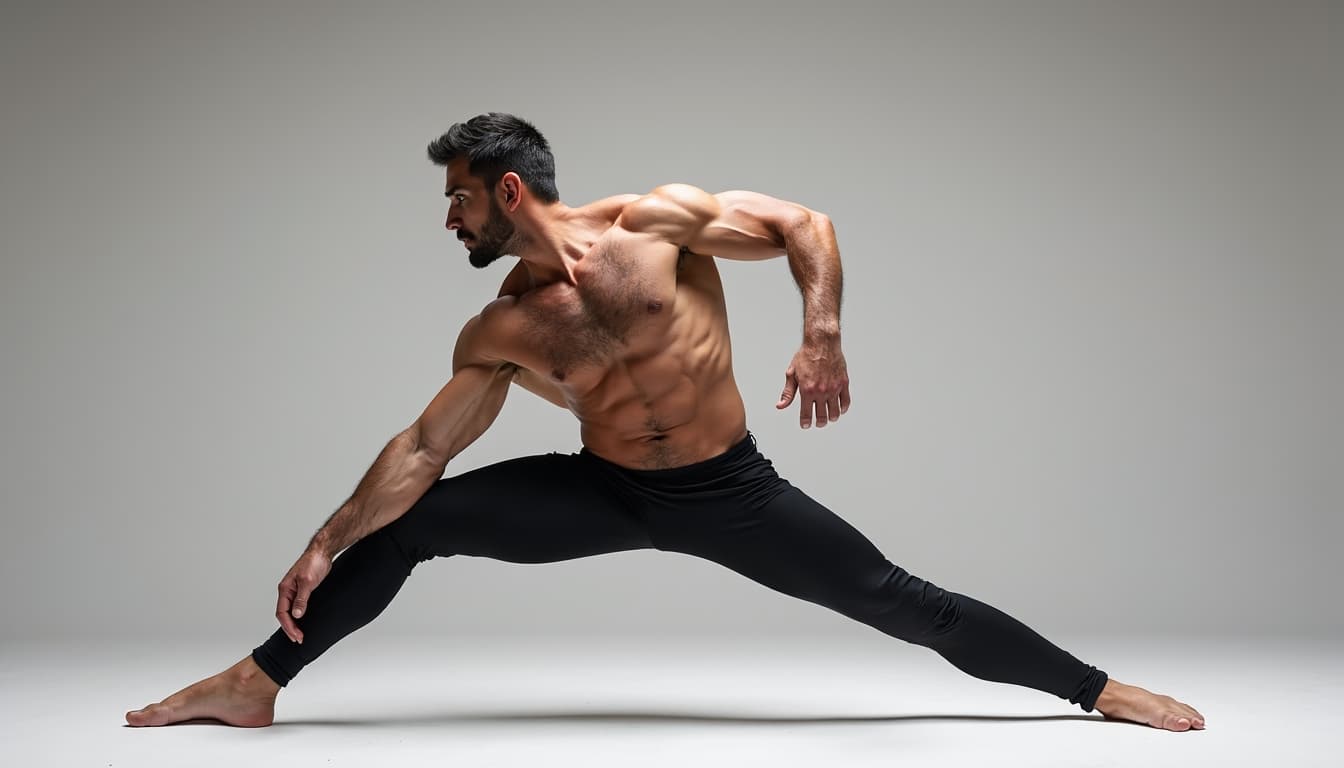تدريب المرونة: البطل المجهول في جولة لياقتك البدنية

في عالم يسيطر فيه القوة، تعد المرونة المفتاح المهمل غالبًا الذي يمكن أن يُحدث ثورة في لعبة لياقتك البدنية. لا تدع إصابة بسيطة تعطل تقدمك؛ اكتشف كيف يعزز تدريب المرونة الأداء، ويزيد القوة، ويحمي مكاسبك. حان الوقت لاحتضان الحامي الصامت في رحلتك الرياضية - سيشكرك جسمك على ذلك!
لنكن صادقين، أيها الشبان. لقد قضيت ساعات عديدة في بناء الجسم الذي تفخر به. لقد قمت بتتبع السعرات الغذائية بدقة، وتحديت حدودك في الجيم، وحققت أفضل أداء لك في الضغط بالبنط، وحطمت أفضل أرقامك في القرفصاء، وتشعر أنك مستعد لمواجهة العالم. لكن هنالك حقيقة قاسية: كل هذا الالتزام يمكن أن يتحطم في ثانية واحدة بسبب إصابة تبدو غير مهمة. تمزق العضلة الخلفية، مشكلة في الظهر، أو مشكلة في الكتف - هذه ليست مجرد نكسات بسيطة؛ إنها تعطيك بعض الاضطرابات الوحشية، وتعطل تقدمك وتجعلك تتخلى عن التمارين وتصبح محبطًا. العنصر الحاسم الذي يتم تجاهله غالبًا في السعي للحصول على عضلات بارزة وبطن مشدودة؟ المرونة. إنها الحامي الصامت لمكاسبك، البطل المجهول في جولة لياقتك البدنية، وتجاهلها هو وصفة للكوارث.
انسى الفكرة القديمة القائلة بأن المرونة مخصصة فقط لممارسة اليوغا والباليه. هذه ليست مجرد مسعى مليء بترديد النمستي. المرونة هي أساس الأداء الرياضي، هي درعك ضد الإصابة، وهي مكون حيوي لصحة ورفاهية الرجل عمومًا، بغض النظر عن مستوى لياقته البدنية أو الأنشطة المختارة. الأمر لا يتعلق بثني نفسك مثل القراطيس (رغم أن ذلك قد يكون مرحًا!)، بل يتعلق بتحسين حركتك، وزيادة قوتك، وبناء جسم ليس فقط قويًا، بل مرنًا. نحن نتحدث عن المرونة الوظيفية - من النوع الذي يحسن من القرفصاء الخاص بك، ويعزز سرعتك، ويمنع تلك الآلام والإزعاجات المزعجة التي يمكن أن تعطل تقدمك. سيتعمق هذا الدليل في "لماذا" و "كيف" و"لماذا الجحيم لم أكن أفعل هذا منذ زمن طويل؟" من تدريب المرونة.
تقييم مرونتك
قبل أن تتمكن من تطويع جسمك المثالي، تحتاج إلى خطة. ينطبق الأمر نفسه على المرونة. إن فهم نقطة انطلاقك أمر بالغ الأهمية قبل أن تبدأ أي برنامج تدريب جاد. ستساعدك هذه التقييمات البسيطة على قياس مستويات مرونتك الحالية:
مرونة الكتف
أولاً، دعونا نفحص مرونة الكتف لديك. مد يدك خلف ظهرك وحاول لمس لوح الكتف المقابل. إلى أي مدى يمكنك الوصول؟ غالبًا ما يترجم نطاق الحركة المحدود هنا إلى صعوبة في تمرينات الضغط العلوي، والتعالي للسحب، بل وحتى المهام اليومية مثل محاولة الوصول إلى شيء ما على رف مرتفع. قد يؤدي التقييد في الحركة أيضًا إلى زيادة احتمالية تعرضك لمشاكل انحشار الكتف. فكر في عدد المرات التي تستعمل فيها الكتفين - هذه منطقة حيوية لتكون على رأس أولوياتك.
مرونة الورك
بعد ذلك، لنقيم مرونة الورك لديك. اجلس على الأرض ومد ساقيك. حاول الوصول إلى أصابع قدميك. إلى أي مدى يمكنك الوصول؟ الوركين المتوترين تعرقل بشكل كبير القرفصاء، والاندفاعات، وقوة الجسم السفلي عموما. كما أنها تسهم في آلام أسفل الظهر ويمكن أن تؤثر على وضعك، مما يؤثر على مظهرك ورفاهيتك العام. فكر في مقدار الوقت الذي تقضيه جالسًا - غالبًا ما يكون هذا مساهمًا كبيرًا في توتر الورك.
مرونة العضلة الخلفية
الآن، دعونا ننظر في مرونة العضلة الخلفية لديك. قف مع قدميك بعرض الورك. انحني لأسفل نحو أصابع قدميك، مع الحفاظ على استقامة ساقيك. إلى أي مدى يمكنك الوصول؟ الخاصة بهذه العضلات الخلفية هي سبب شائع لشد العضلات الخلفية، وآلام أسفل الظهر، وانخفاض سرعة الركض. هذا مهم بشكل خاص لأولئك الذين يستمتعون بالجري أو أي نشاط يتضمن حركات ساق متفجرة.
مرونة الظهر
أخيرًا، دعونا نقيم مرونة ظهرك. قف مع قدميك معًا وانحني إلى الأمام عند الخصر، محاولًا لمس أصابع قدميك. إلى أي مدى يمكنك الوصول؟ يؤثر محدودية مرونة الظهر بشكل كبير على قدرتك على رفع الأوزان الثقيلة وأداء الحركات المركبة مثل الرفعات الميتة بأمان وفعالية. هذا أمر ضروري لأي شخص يشارك في تدريب الأوزان أو الأنشطة التي تتطلب انحناء العمود الفقري بشكل كبير.

هذه الاختبارات البسيطة تقدم لك لمحة عن مرونتك. حدد أضعف المناطق لديك - هذه هي نقاط البداية للتحسين. تذكر، المرونة ليست فقط عن قدرتك على القيام بتمارين محددة؛ إنها تدور حول إطلاق كامل إمكانات جسمك للحركة. فهم الأنواع المختلفة من التمدد أمر حيوي لتحقيق تقدم آمن وفعال:
أنواع التمدد
-
التمدد الساكن يتضمن الحفاظ على التمدد لفترة ممتدة (عادةً من 15 إلى 30 ثانية). هذا ممتاز لتحسين المرونة وتقليل الألم العضلي بعد التمرين. فكر في الأمر كفرصة لإعطاء عضلاتك فرصة للاسترخاء والتمدد.
-
التمدد الديناميكي يتضمن الحركة عبر نطاق من الحركة، حيث يستعد الجسم للنشاط. فكر في دوائر الذراع، وتأرجح الساق، والتواء الجذع. يستحسن استخدام هذا كأسلوب للإحماء قبل التمرين، مما يجعل عضلاتك جاهزة للعمل.
-
التمدد الارتدادي يستخدم حركات الارتداد لدفع جسمك إلى ما بعد نطاق الحركة العادي له. على الرغم من أنه قد يبدو فعّالاً، فإن هذا الأسلوب يحمل خطرًا أكبر للإصابة وينبغي تجنبه بشكل عام، خاصة للمبتدئين. الخطر من الإصابة يتجاوز الفوائد المحتملة، لذا التزم بالأساليب الأكثر أمانًا.
بناء جولة مرونتك
الآن بعد أن قمت بتقييم مرونتك، دعنا نبني روتينًا. لا يتعلق الأمر بحشر كل شيء في جلسة واحدة؛ إنه يتعلق بالجهد المستمر على مر الزمن. فكر في الأمر كماراتون، وليس ركضًا سريعًا.
الإحماء الديناميكي
قبل أن تبدأ في التمدد، يعد الإحماء الديناميكي ضروريًا. يعد هذا بتحضير عضلاتك، وزيادة تدفق الدم، وتحسين مدى الحركة. اقضِ بين 5-10 دقائق في أداء تمارين التمدد الديناميكي مثل:
- دوائر الذراع (للأمام والخلف)
- تأرجح الساق (للأمام، للخلف، وإلى الجوانب)
- التواء الجذع
- الركض العالي
- الركض الخلفي
هذا يجعل الدم يتدفق وعضلاتك تسخن، ما يحضرها للتمددات القادمة.
روتين التمدد الساكن
الآن للجزء الأساسي من روتينك: التمدد الساكن. هنا بعض التمددات الساكنة الأساسية التي تستهدف مجموعات العضلات الأساسية ذات الصلة بالعديد من الأنشطة الرياضية. تذكر، الحركات المضبوطة والتنفس العميق المضبوط أمران بالغ الأهمية. ركز على الشعور في عضلاتك ولا تفرض شيئًا.
-
تمدد العضلة الخلفية (واقفا): قف مع القدمين بعرض الورك. مدد ساق واحدة قليلاً للأمام، وانحن عند الوركين، وامتد نحو أصابع قدميك. احتفظ بالموقف لمدة 30 ثانية، مع التركيز على الاسترخاء في التمدد. كرر على الساق الأخرى.
-
تمدد العضلة الخلفية (جالس): اجلس على الأرض مع الساقين ممدودتين. انحني للأمام من الوركين، ممتدًا نحو أصابع قدميك. احتفظ بهذا الوضع لمدة 30 ثانية.
-
تمدد عضلة الفخذ الرباعية: قف ممسكًا بكرسي أو جدار للتوازن. أثنِ إحدى ركبتيك واسحب كعبك برفق نحو مؤخرتك. احتفظ بهذا الوضع لمدة 30 ثانية.
هل تستمتع بهذا المحتوى؟ ادعم عملنا بزيارة راعي هذا المقال
زيارة الراعي-
تمدد عضلة الساق (ضد الجدار): قف مواجهًا للجدار، وضع ساقًا واحدة قليلاً خلف الأخرى. انحن ضد الجدار، اثنِ ركبتك الأمامية حتى تشعر بالتمدد في عضلة ساقك. احتفظ بهذا الوضع لمدة 30 ثانية.
-
تمدد الصدر: قف وذراعاك ممتدتان للأطراف على ارتفاع الكتف. اعبر ذراعًا واحدةً عبر جسمك، سحبها برفق نحو صدرك بيدك الأخرى. احتفظ بهذا الوضع لمدة 30 ثانية.
-
تمدد العضلة ثلاثية الرأس: ارفع ذراعًا واحدةً فوق الرأس واثنِ عند الكوع، بحيث تصل يدك نحو ظهرك العلوي. واسحب كوعك بلطف بيدك الأخرى لتقربه أكثر. احتفظ بهذا الوضع لمدة 30 ثانية.
-
تمدد الكتف: مد يدًا واحدةً عبر جسمك واحتفظ به عند الكوع بالإمساك به بيدك الأخرى. اسحب ذراعك بلطف عبر جسمك حتى تشعر بالتمدد في كتفك. احتفظ بهذا الوضع لمدة 30 ثانية.
-
تمدد العضلة القابضة للورك: اركع على ركبتيك، وضع القدم الأخرى مسطحة على الأرض أمامك. ادفع وركيك برفق إلى الأمام حتى تشعر بالتمدد في الجهة الأمامية لوركك. احتفظ بهذا الوضع لمدة 30 ثانية.
-
تمدد الفراشة: اجلس وضع بطن القدمين معًا. اضغط بلطف على ركبتيك بمرفقيك حتى تشعر بالتمدد في الفخذين الداخليين. احتفظ بهذا الوضع لمدة 30 ثانية.
-
تمدد أسفل الظهر (قطة-بقرة): ابدأ على يديك وركبتيك. احن ظهرك، ثم قم بجولة ظهرك نحو السقف. كرر عدة مرات.

التهدئة الديناميكية
بعد التمرين، قم بدمج تمارين التمدد الديناميكي لتعزيز الحركة وتحسين الدورة الدموية. تذكر، ينبغي أن تكون هذه الحركات مضبوطة ومتعمدة، وليست مرتعشة أو ارتدادية. كرر كل حركة من 10 إلى 15 مرة.
- دوائر الذراع (للأمام والخلف)
- تأرجح الساق (للأمام، للخلف، وإلى الجوانب)
- التواء الجذع
- دوران الذراع
- رفع الساق
يساعد هذا في تبريد عضلاتك والاستعداد للتعافي.
تقنيات متقدمة
بالنسبة للمستخدمين المتقدمين، يمكن أن يكون تمدد التسهيل العصبي العضلي التناسبي (PNF) فعالًا للغاية. تتضمن هذه التقنية تقلص وإرخاء عضلاتك أثناء التمدد، مما يزيد من مدى حركتك. ومع ذلك، من الأفضل تعلمه تحت إشراف محترف.
أكمل روتينك بتمددات ثابتة، مع الاحتفاظ بكل منها لمدة 20-30 ثانية. يساعد هذا في تقليل الألم العضلي ويعزز التعافي. ركز على نفس التمددات التي قمت بأدائها أثناء التمرين الرئيسي.
استهدف جلسات التمدد اليومية التي تستغرق 10-30 دقيقة. التناسق هو المفتاح؛ حتى الجلسات القصيرة أفضل من الجلسات المطولة غير المنتظمة.
المرونة وأهداف اللياقة البدنية
تمتد فوائد المرونة إلى ما هو أبعد من مجرد تحسين مدى الحركة. إنها محولة اللعبة المفضلة لديك:
تدريب القوة
يعد دمج تدريب المرونة في روتين تدريبات القوة الخاصة بك أمرًا بالغ الأهمية لتعزيز الأداء وتقليل خطر الإصابة. تحسين تدفق الدم، والحد من تصلب العضلات، وتعزيز الحركة، مما يمكنك من رفع أوزان أثقل وأداء الحركات بكفاءة أكبر. ركز على تمديد العضلات التي تم العمل عليها بشكل رئيسي في روتين تدريبات القوة الخاصة بك.
الكاردي
سواء كنت عداءً أو سباحًا أو راكب دراجات،المرونة المحسّنة ضرورية لأداء مثالي وللوقاية من الإصابة. يساعد التمدد على تحسين مدى حركتك، مما يسمح بحركات أكثر كفاءة وتقليل خطر الشد أو التمزقات العضلية. ركز على التمدد الديناميكي قبل جلسات الكاردي والتمدد الساكن بعد ذلك.
أنشطة أخرى
من تسلق الجبال وركوب الدراجات إلى الرياضات الجماعية وحتى الأنشطة اليومية مثل البستنة أو اللعب مع أطفالك، تلعب المرونة دورًا حيويًا. تعمل المرونة المحسّنة على تحسين الأداء، وتعزيز التوازن، وتقليل خطر الإصابة بشكل كبير.
الارتقاء بمرونتك
لأخذ تدريب المرونة إلى مستوى جديد، قم بدمج هذه التقنيات:
-
اللف الرغوي يساعد على تخليص العضلات من التوتر، وتعزيز تدفق الدم، وتحسين المرونة. أمضي من 5 إلى 10 دقائق في لف المجموعات العضلية الرئيسية التي عملت عليها، مع التركيز على مناطق التوتر.
-
اليوغا والبييلات استثنائية لبناء المرونة، تعزيز قوة القلب وتحسين وعي الجسم. غالبًا ما تنطوي على فصول جماعية، مما يوفر فرصة اجتماعية رائعة.
التعامل مع ألم العضلات والاعتبارات
ألم العضلات أمر طبيعي، خاصًة عند البدء. قم بزيادة شدة وتمديد فترة تمددك تدريجيًا، و تذكر أن تمدد المستمر بلطف أكثر فعالية من دفع نفسك بقوة في وقت مبكر جدًا. استمع إلى جسمك ولا تتردد في أخذ أيام راحة عند الحاجة.
إذا كان لديك أي حالات صحية مسبقة أو إصابات، استشر أخصائي علاج طبيعي أو مدرب معتمد قبل بدء أي برنامج لياقة جديد. يمكنهم إنشاء خطة شخصية تلبي احتياجاتك وقيودك الخاصة، مما يساعدك على تحقيق أهداف المرونة الخاصة بك بأمان وفعالية.
باختصار: المرونة ليست رفاهية؛ إنها ضرورة لحياة متوازنة جيدًا وصحية وخالية من الإصابات. من خلال دمج هذه الاستراتيجيات في روتينك، لن تقوم فقط بتحسين أدائك الرياضي ولكن أيضًا تقليل خطر الإصابة، وتحسين وضعك، والاستفادة من مجموعة متنوعة من الفوائد مثل تحسين التعافي العضلي والرفاه البدني العام. اجعل المرونة التزامًا مدى الحياة - إنها استثمار في مستقبلك، صحتك، وقدرتك على الاستمرار في دفع حدودك البدنية. ابدأ رحلتك نحو المرونة اليوم. سيشكرك ذاتك الأقوى، الأكثر مرونة، والأكثر حرصًا على الاستعراض.



